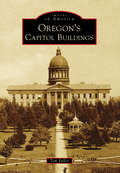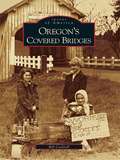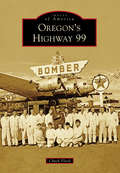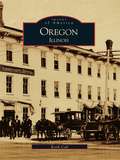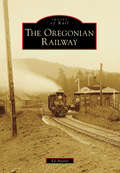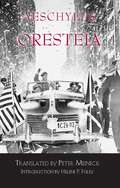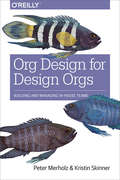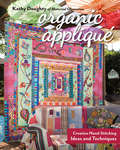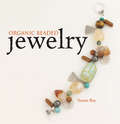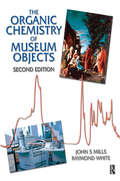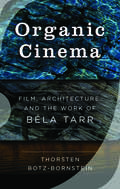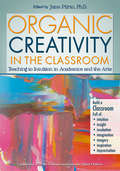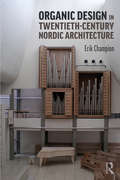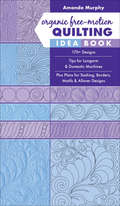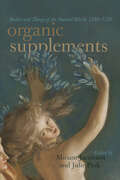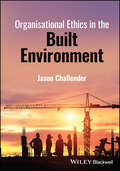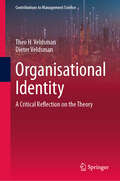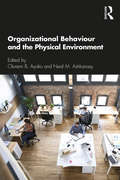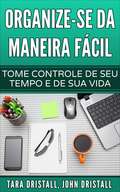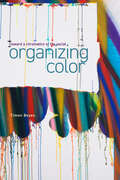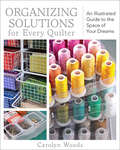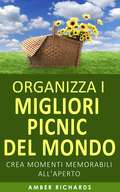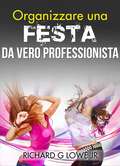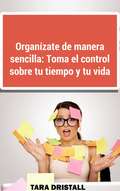- Table View
- List View
Oregon's Capitol Buildings (Images of America)
by Tom FullerThe state of Oregon has had not one, not two, but three state capitol buildings. Two of them met a sudden and unexpected end--destruction by fire. William Willson, a pioneer of Salem, donated some acres from his Donation Land Claim for a state capitol. The first, built in 1855, may have been torched in a desperate fight to move the capitol to Corvallis. A second capitol, built in 1873, was patterned after the US Capitol in Washington, DC. This capitol, adorned with a beautiful copper-clad dome, faced west toward the Willamette River. On April 25, 1935, a fire started in a basement storage area. It quickly spread to the whole structure, and within four hours, the entire thing lay in ruins. After an exhaustive design process, a new capitol was built in the midst of the Great Depression, topped with a golden pioneer.
Oregon's Covered Bridges
by Bill CockrellRugged individuals armed with hand tools, sweat, and ambition began building covered bridges in Oregon during the mid-1850s. These bridge builders often camped out at remote sites, living off the land or contracting with local farmers for food. Early owners of covered bridges financed construction by charging tolls--3¢ for a sheep, 5¢ for a horse and rider, and 10¢ for a team of horses and wagon. In the early 20th century, the state provided standard bridge and truss designs to each county, and most of the resulting structures incorporated the Howe truss. With the abundance of Douglas fir and the shortage of steel during the world wars, the construction of wooden covered bridges continued well into the 1950s, mainly in the Willamette Valley. During the 1920s, Oregon boasted more than 350 covered bridges.
Oregon's Highway 99 (Images of America)
by Chuck FloodFrom the Columbia River to the Siskiyou Mountains, Highway 99 traverses 300 miles of western Oregon. Big cities and small towns, the level Willamette Valley and steep hills, rich agricultural lands and tall evergreen forests, and rushing rivers all lie along its path. Arising from an early network of emigrant trails, stagecoach routes, and farm-to-market roads, the highway had developed into Oregon's major transportation corridor by the end of the 19th century. The dawn of the automobile age saw an exponential increase in traffic, creating a greater demand for improved roads; these better roads, in turn, created yet more traffic for both business and recreation. Roadside businesses, such as auto courts, restaurants, and service stations, sprang up along the highway to cater to a new type of motorist--the tourist. Today, much of Highway 99 and its predecessor, the Pacific Highway, remain in daily use.
Oregon, Illinois (Images of America)
by Keith CallOregon, Ill., the administrative seat of Ogle County, lies midway between Rockford and Dixon. From its four state parks to Stronghold Castle, and from quiet tree-lined avenues to the regal Blackhawk statue, Oregon has long provided a haven for tourists, campers, boy scouts, church retreats, and artists: anyone seeking a unique taste of small town Midwestern life. In the early 1830s, pioneer John Phelps journeyed into the Rock River valley, eager to explore. He befriended Native Americans and enjoyed the land, but harbored no intent to stay. However, he wrote that "these beautiful undulating and rich prairies left an impression on my memory that no time could erase." Thus, at the suggestion of surveyor Colonel William S. Hamilton, son of Alexander Hamilton, he built a cabin, planted a crop, and staked his claim. Others wisely followed Phelps, and have been following ever since. Through text and images,Oregon, Illinois seeks to chronicle the story of a most remarkable community whose rich heritage reaches back nearly to the founding of this nation.
Oregonian Railway, The
by Ed AustinTo those with an interest in railroad history in the United States, mention of the words "narrow gauge" may bring to mind the extensive three-foot-gauge railroads of Colorado and Utah or perhaps the famous two-foot-gauge lines in Maine. However, few would think first of Oregon and the Pacific Northwest. Nonetheless, between 1877 and 1893, an extensive narrow-gauge railroad developed in Oregon-- one that had aspirations of crossing the Cascade Mountains and connecting with the Central Pacific Railroad, thus giving Oregon its first access to the transcontinental railroad system. It is this railroad system, from its inception in 1877 to the present day, that Ed Austin explores herein.
Oresteia: Volume I: The Oresteia (Hackett Classics)
by Helene P. Foley Aeschylus Peter MeineckMeineck's translation is faithful and supple; the language employed is modern without betraying the grandeur and complexity--particularly the images--of the Aeschylean text. After reading this translation, one has but one further wish: to see it and hear it at Delphi, Epidaurus or Syracuse. --Herman Van Looy, L'Antiquite Classique
Org Design for Design Orgs: Building and Managing In-House Design Teams
by Peter Merholz Kristin SkinnerDesign has become the key link between users and today’s complex and rapidly evolving digital experiences, and designers are starting to be included in strategic conversations about the products and services that enterprises ultimately deliver. This has led to companies building in-house digital/experience design teams at unprecedented rates, but many of them don’t understand how to get the most out of their investment. This practical guide provides guidelines for creating and leading design teams within your organization, and explores ways to use design as part of broader strategic planning.You’ll discover:Why design’s role has evolved in the digital ageHow to infuse design into every product and service experienceThe 12 qualities of effective design organizationsHow to structure your design team through a Centralized PartnershipDesign team roles and evolutionThe process of recruiting and hiring designersHow to manage your design team and promote professional growth
Organic Appliqué: Creative Hand-Stitching, Ideas and Techniques
by Kathy DoughtyPractice taking color and design risks with an inside look at the process of Australia’s renowned quilting designer and owner of Material Obsession.Explore the use of symbols, pattern, colors, and techniques to make textile creations that reflect your perspective. With its organic lines, hand appliqué is the perfect medium for artistic expression. Come into the studio with Kathy Doughty as she shares her passion for quilt design, needle-turn appliqué, and fabric selection. Create quilt magic with eight distinctive projects and full-size patterns to inspire your imagination. Build your skill set with easy, step-by-step instructions for Broderie Perse, Boro-style appliqué, paper piecing, and hand quilting. Take control of the creative process, experiment with color, and achieve your creative goals!Everything you need to appliqué quilts in Kathy’s style or your own! Choose fabric, make bias vines, master needle-turn, and much moreAdd to your skills with intermediate and advanced techniques you haven’t seen before, with simple instructions that beginners can easily follow“Any aspiring quiltmaker should count themselves fortunate to have such an inspiring soul to guide and encourage them as Kathy Doughty.” —Kaffe Fassett
Organic Beaded Jewelry
by Susan RayThe excitement surrounding jewelry making is based, in part, on the wide variety of materials available. Organic Beaded Jewelry bridges the gap between assorted materials used to create find jewelry, and demonstrates techniques to make truly unique items. Organic jewelry accounts for something with a natural form, shape or function, or items made from natural materials or those that mimic nature. Whether its precious metal or polymer clay, glass, and gemstones, this complete reference offers options for more than 40 stunning pieces of jewelry including necklaces and bracelets. In addition to more than 150 color illustrations, the book includes the techniques and creativity of other well-known artists, for an unrivaled how-to resource!
Organic Chemistry of Museum Objects
by John Mills Raymond White'The Organic Chemistry of Museum Objects' makes available in a single volume, a survey of the chemical composition, properties and analysis of the whole range of organic materials incorporated into objects and artworks found in museum collections. The authors cover the fundamental chemistry of the bulk materials such as wood, paper, natural fibres and skin products, as well as that of the relatively minor components incorporated as paint, media, varnishes, adhesives and dyes. This expanded second edition, now in paperback, follows the structure of the first, though it has been extensively updated. In addition to chapters on basic organic chemistry, analytical methods, analytical findings and fundamental aspects of deterioration, the subject matter is grouped as far as possible by broad chemical class - oils and fats, waxes, bitumens, carbohydrates, proteins, natural resins, dyestuffs and synthetic polymers. This is an essential purchase for all practising and student conservators, restorers, museum scientists, curators and organic chemists.
Organic Cinema: Film, Architecture, and the Work of Béla Tarr
by Thorsten Botz-BornsteinThe “organic” is by now a venerable concept within aesthetics, architecture, and art history, but what might such a term mean within the spatialities and temporalities of film? By way of an answer, this concise and innovative study locates organicity in the work of Béla Tarr, the renowned Hungarian filmmaker and pioneer of the “slow cinema” movement. Through a wholly original analysis of the long take and other signature features of Tarr’s work, author Thorsten Botz-Bornstein establishes compelling links between the seemingly remote spheres of film and architecture, revealing shared organic principles that emphasize the transcendence of boundaries.
Organic Crafts: 75 Earth-Friendly Art Activities
by Kimberly MonaghanParents, teachers, and caregivers looking for ideas on how to get children outdoors and instill in them a love of nature can find more than 75 creative crafts, games, and activities using objects that kids can collect from nature in this idea book. As children make race cars out of rocks, create paint from plants, and assemble funny grass masks, they learn to be environmentally friendly--absorbing information on recycling, reducing waste, and inspiring others to protect nature. Organized by the various natural materials needed, the crafts offer a new twist on perennial homemade gifts and school projects.
Organic Creativity in the Classroom: Teaching to Intuition in Academics and the Arts
by Jane PiirtoOrganic Creativity in the Classroom demonstrates an approach to teaching creatively-teaching to intuition-that is written by experienced, award-winning classroom teachers. Instead of focusing on divergent production skills such as fluency and flexibility, an outdated approach that dominates the field of creativity studies, this book includes helpful strategies that can be used to encourage students to become more creative within a specific domain. Teachers of writing, mathematics, science, social science, literature, foreign language, theater, songwriting, psychology, comparative religion, and arts education, among other domains, who infuse creativity and intuition into their classrooms share their practical advice using an insightful storytelling approach.
Organic Design in Twentieth-Century Nordic Architecture
by Erik ChampionOrganic Design in Twentieth-Century Nordic Architecture presents a communicable and useful definition of organic architecture that reaches beyond constraints. The book focuses on the works and writings of architects in Nordic countries, such as Sigurd Lewerentz, Jørn Utzon, Sverre Fehn and the Aaltos (Aino, Elissa and Alvar), among others. It is structured around the ideas of organic design principles that influenced them and allowed their work to evolve from one building to another. Erik Champion argues organic architecture can be viewed as a concerted attempt to thematically unify the built environment through the allegorical expression of ongoing interaction between designer, architectural brief and building-as-process. With over 140 black and white images, this book is an intriguing read for architecture students and professionals alike.
Organic Free-Motion Quilting Idea Book
by Amanda MurphyLet Mother Nature inspire your quilting with this guide full of inspiring ideas, techniques, and tips from the acclaimed fabric and quilt designer.Following the success of her Free-Motion Quilting Idea Book and Rulerwork Quilting Idea Book, Amanda Murphy shares an all-new volume packed with exciting designs. This handy guide provides more than one hundred original ideas inspired by the elements around you—water, air, feathers, ferns, leaves, sticks, stones, flowers, and fire. Amanda’s step-by-step instructions will help you gain confidence in your free-motion work. Then she offers a myriad of ideas organized by element and design type for you to you branch out and get creative. With Organic Free-Motion Quilting Idea Book, you can add texture, movement, and a sense of the natural world to your quilting, whether you're sewing on a domestic sewing machine or a longarm.
Organic Supplements: Bodies and Things of the Natural World, 1580–1790
by Jessica Wolfe Julia Reinhard Lupton Rebecca Laroche Kevin Lambert Michael Yonan Diane Purkiss Professor Lynn Festa Professor Jayne Elizabeth LewisFrom the hair of a famous dead poet to botanical ornaments and meat pies, the subjects of this book are dynamic, organic artifacts. A cross-disciplinary collection of essays, Organic Supplements examines the interlaced relationships between natural things and human beings in early modern and eighteenth-century Europe. The material qualities of things as living organisms—and things that originate from living organisms— enabled a range of critical actions and experiences to take place for the people who wore, used, consumed, or perceived them.
Organisational Ethics in the Built Environment
by Jason ChallenderOrganisational Ethics in the Built Environment A comprehensive analysis of the critical role played by ethics in construction organisations, and a toolkit for implementing a strong ethical culture In Organisational Ethics in the Built Environment, accomplished construction leader Jason Challender delivers an insightful and important resource for construction industry professionals contributing to the creation of safe and suitable projects. The author explains how to construct the foundation for ethical building and business practices in the construction industry, and explores the methods, motives and rationales behind successful and ethical projects from an organisational and industry perspective. You’ll learn how practical improvements to organisational ethics can promote ethical standards, behaviours and practices and influence the success of projects in the built environment. You’ll also discover the importance of leadership, motivational management, human resource management, corporate responsibility and social value in encouraging strict compliance and adherence to ethical principles, values and standards within organisations. Readers will also find: A thorough introduction to the critical importance of trust, collaborative working and partnering arrangements in contemporary construction and engineering organisations Comprehensive explorations of the relevance of environmental ethics Practical discussions of how to link corporate policies and strategies to ethical guidelines Case studies from across a variety of knowledge fields, including manufacturing and retail Perfect for construction managers, Organisational Ethics in the Built Environment will also benefit undergraduate and postgraduate students of construction, business, management, engineering and other construction related subjects.
Organisational Identity: A Critical Reflection on the Theory (Contributions to Management Science)
by Dieter Veldsman Theo H VeldsmanThis book addresses the pressing need for a comprehensive understanding of Organisational Identity (OI) as essential to building effective, viable, and credible organisations. Its purpose is to provide the reader with insight into OI from a theoretical and practical vantage point, using leading OI practices to assist organisations to become identity-directed and -guided. The five primary contributions of the book are: an enriched conceptualization of OI grounded in a firm moral base; an OI framework that integrates systemic meta-theoretical thinking and practice; an analysis of OI from the vantage point of the New World of Work; a discussion of VICCAS World-related OI themes; and a perspective of OI that critically reflects from practice on OI theory.
Organizational Behaviour and the Physical Environment
by Neal M. Ashkanasy Oluremi B. AyokoThis book looks at how the physical environment of work shapes organizational behaviour, demonstrating that our physical surroundings at work can have a big influence on employee productivity, performance and wellbeing. Drawing upon the latest research, Organizational Behaviour and the Physical Environment provides comprehensive coverage of the different aspects of the physical environment at work – the buildings, furnishings, equipment, lighting, air quality and their configurations. From theories of psychological ownership and work design, to cultural issues and technology in the workplace, its international range of contributors provide voices from Australasia, North America, Europe and the Middle East. This book will be invaluable supplementary reading for advanced students, researchers and practitioners across the fields of organizational behaviour, HRM, organizational and environmental psychology, and workspace design.
Organize-se da maneira fácil: Tome controle de seu tempo e de sua vida
by John Dristall Tara Dristall DereckEste livro te ajuda a se organizar através da simplicidade. Você não precisa de um sistema de gestão de tempo complicado, ou um planejador cheio com cada tarefa descrita até o último detalhe. Você precisa de um sistema básico que dê conta do recado sem se tornar um projeto em si. Os autores dão conselhos práticos para se organizar em todos os aspectos de sua vida: • Organizando sua mesa e papelada • Controlando seu computador e smartphone ao invés de ser controlado por eles • Controlando suas finanças • Dicas rápidas para organizar sua casa • Controle e planejamento de tempo • Organizando-se como uma família Os autores incluem um questionário simples no começo de cada capítulo para que você possa acompanhar onde você está e onde precisa melhorar. Este livro vai te ajudar a tomar conta dos detalhes, livrar-se da pressão da sobrecarga e encontrar mais satisfação em sua vida.
Organizing Color: Toward a Chromatics of the Social (Sensing Media: Aesthetics, Philosophy, and Cultures of Media)
by Timon BeyesWe live in a world that is saturated with color, but how should we make sense of color's force and capacities? This book develops a theory of color as fundamental medium of the social. Constructed as a montage of scenes from the past two hundred years, Organizing Color demonstrates how the interests of capital, management, governance, science, and the arts have wrestled with color's allure and flux. Beyes takes readers from Goethe's chocolate experiments in search of chromatic transformation to nineteenth-century Scottish cotton mills designed to modulate workers' moods and productivity, from the colonial production of Indigo in India to globalized categories of skin colorism and their disavowal. Tracing the consumption, control and excess of industrial and digital color, other chapters stage encounters with the literary chromatics of Pynchon's Gravity's Rainbow processing the machinery of the chemical industries, the red of political revolt in Godard's films, and the blur of education and critique in Steyerl's Adorno's Grey. Contributing to a more general reconsideration of aesthetic capitalism and the role of sensory media, this book seeks to pioneer a theory of social organization—a "chromatics of organizing"—that is attuned to the protean and world-making capacity of color.
Organizing Solutions for Every Quilter: An Illustrated Guide to the Space of Your Dreams
by Carolyn WoodsA professional organizer&’s handy guide to creating an uncluttered, inviting quilting space for yourself—whether it&’s a small closet or a large studio. This practical guide shows you how to organize and maintain your quilting space, no matter what size. Learn handy ways to sort and arrange all of your fabrics and supplies into easy-to-use stations—and find actual organizing solutions from quilters&’ studios, including Alex Anderson and Diana McClun. Create a calm and happy place for all your beloved fabrics, books, notions, tools, and even UFOs (unfinished objects). With colorful photos, you'll see real examples of what makes an efficient, functional, and inviting quilting space. You'll identify what's causing the clutter, learn how to turn it into a more creative zone, and find more time to do what you love—quilt!
Organizza i migliori picnic del mondo
by Simona Trapani Amber RichardsLa maggior parte delle persone amano mangiare ed amano l'aria aperta! Unite le due cose ed avrete qualcosa di speciale!... SE avete un piano. Organizza i migliore picnic del mondo è una guida semplice ma completa per diventare esperti nell'arte del picnic. Sia che si tratti di una fuga romantica per due sulla spiaggia o di una gita di famiglia al parco locale, vi assicuriamo che troverete il posto perfetto, il cibo perfetto, la strategia perfetta, e che non ci sarà nemmeno una nuvola nel cielo (quest'ultimo elemento non è garantito)! Dopo tutto, non vorrete di certo avere a che fare con cibo andato a male, invasioni di insetti e un pulmino pieno di bambini di cattivo umore! O con un primo appuntamento che si conclude con un salvataggio in elicottero. Ovviamente no! Se avete intenzione di passare del tempo all'aperto, preparate del cibo! Organizza i migliori picnic del mondo è una guida pratica per organizzare picnic sempre perfetti. Scaricate la vostra copia adesso.
Organizzare una festa da vero professionista
by Richard G Lowe Jr Silvia LiguoriGli anni precedenti la scomparsa di mia moglie, ero una di quelle persone che si possono definire introverse. Lavoravo nell'industria informatica, dipingevo miniature di fantasia, collezionavo francobolli ed ero un lettore appassionato. Il filo conduttore di tutte queste attività era il fatto che non fossero coinvolte altre persone. Tutto è cambiato però dopo la morte di mia moglie. La sensazione di dolore era devastante e dovevo fare qualcosa per uscire da quel tunnel oscuro e profondo. Coloro tra voi che hanno vissuto un lutto possono comprendere quel che sto dicendo. Il lutto è un luogo pericoloso in cui sprofondare: in esso non c'è proprio niente di salutare. Mi sono avvicinato alla fotografia e sono andato a immortalare la natura nei parchi nazionali, statali e locali della California del sud. Ho iniziato ad andare alle fiere, soprattutto al Festival rinascimentale locale. Mi sono imposto di essere più “social” e socievole, nonostante questo andasse contro una personale mentalità introversa. Ho iniziato a partecipare alle feste. Anche prima ovviamente ero stato ad altre feste, ma in generale ero parecchio riluttante e non mi fermavo mai troppo a lungo. Arrivavo senza buttarmi subito nella mischia e spesso gli altri invitati non si accorgevano nemmeno che fossi lì anch'io. Ora è tutto diverso per me. Quel tunnel oscuro di dolore non faceva per me. Stare all'aria aperta e frequentare altra gente mi ha guidato verso la mia rinascita. La cosa interessante dei festival rinascimentali è la natura sociale delle persone coinvolte. In men che non si dica ero diventato già il fotografo ufficiale del Festival del Rinascimento e mi invitavano alle loro feste ed eventi sociali. Un mondo completamente nuovo per me, un mondo di socializzazione con altre persone. All'inizio, non avevo la minima idea di cosa fare e mi sentivo un po' spaesato. Dopo aver conosciuto nuova gente a feste ed eventi, si è aperto uno spiraglio e ho ricominciato a divertirmi.
Organízate de manera sencilla: Toma el control sobre tu tiempo y tu vida
by John Dristall Tara Dristall Álvaro Gutiérrez SanchezEste libro te ayudará a organizarte a través de métodos sencillos. No necesitas un complicado sistema para planificar el tiempo, ni una agenda llena de todas las tareas que tienes que hacer, explicadas hasta el más mínimo detalle. Lo que necesitas es un método que funcione sin llegar a convertirse en una carga. Los autores dan consejos prácticos para que aprendas a mejorar la organización en todos los aspectos de tu vida: - Cómo ordenar tu escritorio y tus papeles. - Cómo aprovechar al máximo las ventajas de tu ordenador y tu smartphone sin dejar que estos te controlen. - Cómo controlar mejor tus finanzas. - Consejos rápidos para limpiar tu casa de trastos. - Cómo planificar mejor tu tiempo. - Cómo organizar la vida en familia. Los autores incluyen un cuestionario de autoevaluación al comienzo de cada capítulo para que puedas comprobar cómo vas y dónde puedes mejorar en cada aspecto. Este libro te enseñará a encargarte de los detalles, liberarte de la presión provocada por el exceso de compromisos y a encontrar una mayor satisfacción en tu vida.
